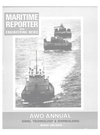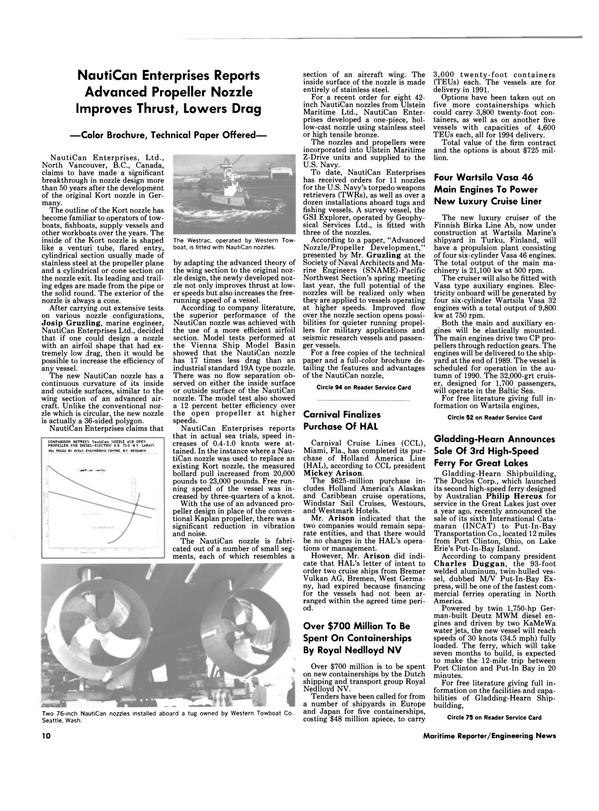
N a u t i C a n Enterprises Reports Advanced Propeller Nozzle Improves Thrust, Lowers Drag
—Color Brochure, Technical Paper Offered— NautiCan Enterprises, Ltd., North Vancouver, B.C., Canada, claims to have made a significant breakthrough in nozzle design more than 50 years after the development of the original Kort nozzle in Germany.
The outline of the Kort nozzle has become familiar to operators of towboats, fishboats, supply vessels and other workboats over the years. The inside of the Kort nozzle is shaped like a venturi tube, flared entry, cylindrical section usually made of stainless steel at the propeller plane and a cylindrical or cone section on the nozzle exit. Its leading and trailing edges are made from the pipe or the solid round. The exterior of the nozzle is always a cone.
After carrying out extensive tests on various nozzle configurations, Josip Gruzling, marine engineer, NautiCan Enterprises Ltd., decided that if one could design a nozzle with an airfoil shape that had extremely low drag, then it would be possible to increase the efficiency of any vessel.
The new NautiCan nozzle has a continuous curvature of its inside and outside surfaces, similar to the wing section of an advanced aircraft.
Unlike the conventional nozzle which is circular, the new nozzle is actually a 36-sided polygon.
NautiCan Enterprises claims that by adapting the advanced theory of the wing section to the original nozzle design, the newly developed nozzle not only improves thrust at lower speeds but also increases the freerunning speed of a vessel.
According to company literature, the superior performance of the NautiCan nozzle was achieved with the use of a more efficient airfoil section. Model tests performed at the Vienna Ship Model Basin showed that the NautiCan nozzle has 17 times less drag than an industrial standard 19A type nozzle.
There was no flow separation observed on either the inside surface or outside surface of the NautiCan nozzle. The model test also showed a 12 percent better efficiency over the open propeller at higher speeds.
NautiCan Enterprises reports that in actual sea trials, speed increases of 0.4-1.0 knots were attained.
In the instance where a NautiCan nozzle was used to replace an existing Kort nozzle, the measured bollard pull increased from 20,000 pounds to 23,000 pounds. Free running speed of the vessel was increased by three-quarters of a knot.
With the use of an advanced propeller design in place of the conventional Kaplan propeller, there was a significant reduction in vibration and noise.
The NautiCan nozzle is fabricated out of a number of small segments, each of which resembles a section of an aircraft wing. The inside surface of the nozzle is made entirely of stainless steel.
For a recent order for eight 42- inch NautiCan nozzles from Ulstein Maritime Ltd., NautiCan Enterprises developed a one-piece, hollow- cast nozzle using stainless steel or high tensile bronze.
The nozzles and propellers were incorporated into Ulstein Maritime Z-Drive units and supplied to the U.S. Navy.
To date, NautiCan Enterprises has received orders for 11 nozzles for the U.S. Navy's torpedo weapons retrievers (TWRs), as well as over a dozen installations aboard tugs and fishing vessels. A survey vessel, the GSI Explorer, operated by Geophysical Services Ltd., is fitted with three of the nozzles.
According to a paper, "Advanced Nozzle/Propeller Development," presented by Mr. Gruzling at the Society of Naval Architects and Marine Engineers (SNAME)-Pacific Northwest Section's spring meeting last year, the full potential of the nozzles will be realized only when they are applied to vessels operating at higher speeds. Improved flow over the nozzle section opens possibilities for quieter running propellers for military applications and seismic research vessels and passenger vessels.
For a free copies of the technical paper and a full-color brochure detailing the features and advantages of the NautiCan nozzle, C i r c l e 9 4 on Reader Service Card
Read N a u t i C a n Enterprises Reports Advanced Propeller Nozzle Improves Thrust, Lowers Drag in Pdf, Flash or Html5 edition of March 1989 Maritime Reporter
Other stories from March 1989 issue
Content
- HBC Barge Acquired By Trinity Industries page: 5
- Marine Interiors Offers Free Literature Listing Products And Services page: 6
- M a r i t i m e London 8 9 To Be Held April 17-21 In City Of London page: 6
- Swagelok Quick-Connects With Heavy-Duty Body Sleeve Now Available page: 8
- Palmer Offers Brochure On Cavitation-Reducing Polymer Coatings page: 8
- T w i n Disc Expands M a r i n e Transmission Series For Workboat Applications page: 9
- Soundcoat Offers Brochure On Vibration-Dissipating Noise Reduction Material page: 9
- N a u t i C a n Enterprises Reports Advanced Propeller Nozzle Improves Thrust, Lowers Drag page: 10
- Gladding-Hearn Announces Sale Of 3rd High-Speed Ferry For Great Lakes page: 10
- Avondale Boat Division Building 400-Passenger SES Ferry page: 11
- Lykes Names Two Senior VPs And Three New VPs page: 11
- Navigation & Communications Equipment Review page: 12
- N A V Y — A $35-BILLION ANNUAL MARKET page: 25
- MAJOR NAVY CONTRACTS page: 27
- ASNE-Mechanicsburg Section To Host Annual N a v a l Logistics Symposium In Carlisle, Pa., O n March 7 -9 page: 30
- Newest Navy Crane Ship Christened 'Diamond State' At Tampa Shipyards page: 31
- Southwest M a r i n e Drydocks Two N a v y Vessels Simultaneously For Extensive Repair Work page: 34
- Portland Ship Repair Yard Posts Successful Year page: 34
- Eldec Corporation And Dunlop Limited Form Joint Venture Company page: 34
- Dampa Appoints Hopeman Brothers Sole U.S. Distributor page: 35
- Compass Display Protected From Abrasion By Coating page: 36
- ABS Forms Corporate Quality Assurance Group page: 36
- Imperial Immersion Suits Save Lives; Survivors Get Club Membership page: 36
- SSE Launches New Class Corvette For Singapore Navy page: 38
- L&C Associates Offers Brochure On Marine Dehumidification Service page: 38
- Rolla's New Five-Bladed REXP5 Propeller Represents Breakthrough In Design page: 38
- Cargocaire Introduces Marine Dehumidifier page: 39
- Marinette Marine Tests MCM-2 Propulsion Plant page: 40
- New Generator Line From Marathon Electric page: 40
- Pan American Hovercraft Offers Color Brochure On New Design Hovercraft page: 43
- VPSI Completes Crankshaft Contract page: 43
- A W O Acclaimed For Quick, Decisive Action To Combat Drought Effects page: 44
- CABOTAGE: I N THE INTEREST OF N A T I O N A L DEFENSE A ND COMMERCE page: 46
- SUCCESS O N TAX FRONT DOMINATED 100TH CONGRESS page: 47
- W O R K I N G TOWARD CLEAN AIR A ND CLEAN WATER page: 49
- Muller Appointed Assistant VP-Operations At Moran Towing page: 51
- A W O Annual M e e t i n g To Be Held In Washington, D.C. April 6 -7 page: 51
- Literature Available On Circle Seal's Plastic Inline Check/Relief Valves page: 51
- New Commuting Service Begins Between New Jersey And New York page: 51
- New Engine Analyzer Reduces Fuel Costs On Marine Diesels page: 52
- American United Marine Wins Achievement Award For TFC Compactor Sales page: 52
- First U.S. Commercial SWATH To ABS Class Under Construction page: 53
- Unitor Ship's Hospital, Safety And Maintenance Equipment Chosen For 'Royal Viking Sun' page: 53
- Aluminum Boats Delivers 150-Passenger Excursion Boat To Maryland Tours page: 63
- Alfa Products Introduces New Boat Bilge Cleaner —Literature Available page: 63


